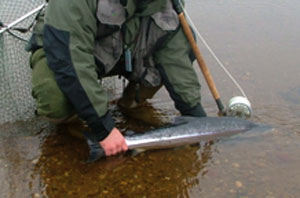
A GROUND-BREAKING agreement between netsmen and anglers to conserve spring salmon runs in some of Scotland’s best known west coast waters, has been struck by the Lochaber District Salmon Fishery Board (LDSFB).
The deal which covers rivers like the Lochy, Coe, Shiel and Leven, will run for six years, and delivers:
- zero netting until May 31
- 100% catch and release of all wild salmon until June 15
Jon Gibb, LDSFB clerk, hailed the agreement as “one of the most important salmon conservation measures in the west highlands in recent times.”
Bag netting in Cuil Bay near Duror in Loch Linnhe has been tenanted for more than 40 years by the same individual and is the largest on the west coast of Scotland outside Dumfriesshire. The nets operate from February to August.

Gibb applauded the netsmen’s decision as “highly commendable” given the importance of spring fish to their annual revenue. He added:
“All of them share our view that, without a recovery of spring salmon stocks, any further exploitation is both unwise and probably unsustainable.
“This is particularly relevant in an area of the country where runs of migratory fish have declined at an even greater rate than the national average of the last two decades – a phenomenon that most agree has been caused by the rapid expansion of salmon farming.”
Around 300 local salmon anglers in community angling clubs are important stakeholders in Lochaber’s rivers, holding leases on their own stretches. All proprietors and angling associations have signed up to the plan which formalises existing voluntary arragnements aimed at ensuring spring fish have maximum chances of spawning and thus boosting fragile populations.
Salmon and sea trout numbers in Lochaber were decimated in the 1990s, but are making a gradual recovery thanks to improvement management strategies and restocking efforts. The River Lochy recorded 32 fish in 1998 compared with 1500 in 2005 and 2007.
That river alone brings in £300,000 annually in visitor income to the Fort William area and supports three full-time and six part-time local jobs. It is one of the most sought-after waters, with a waiting list for beats.